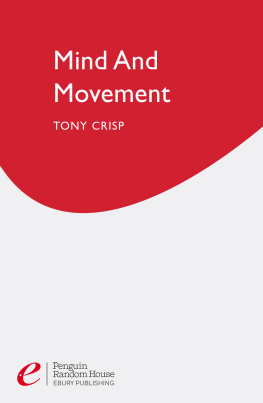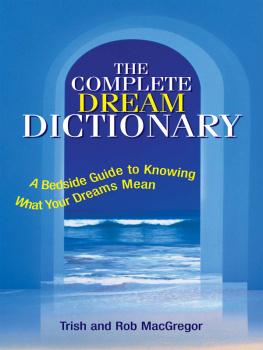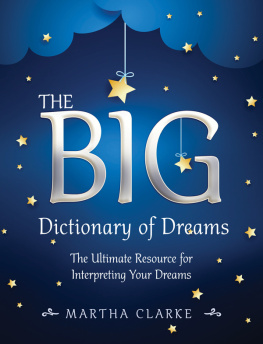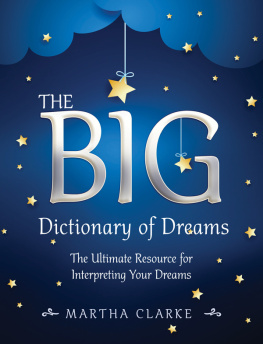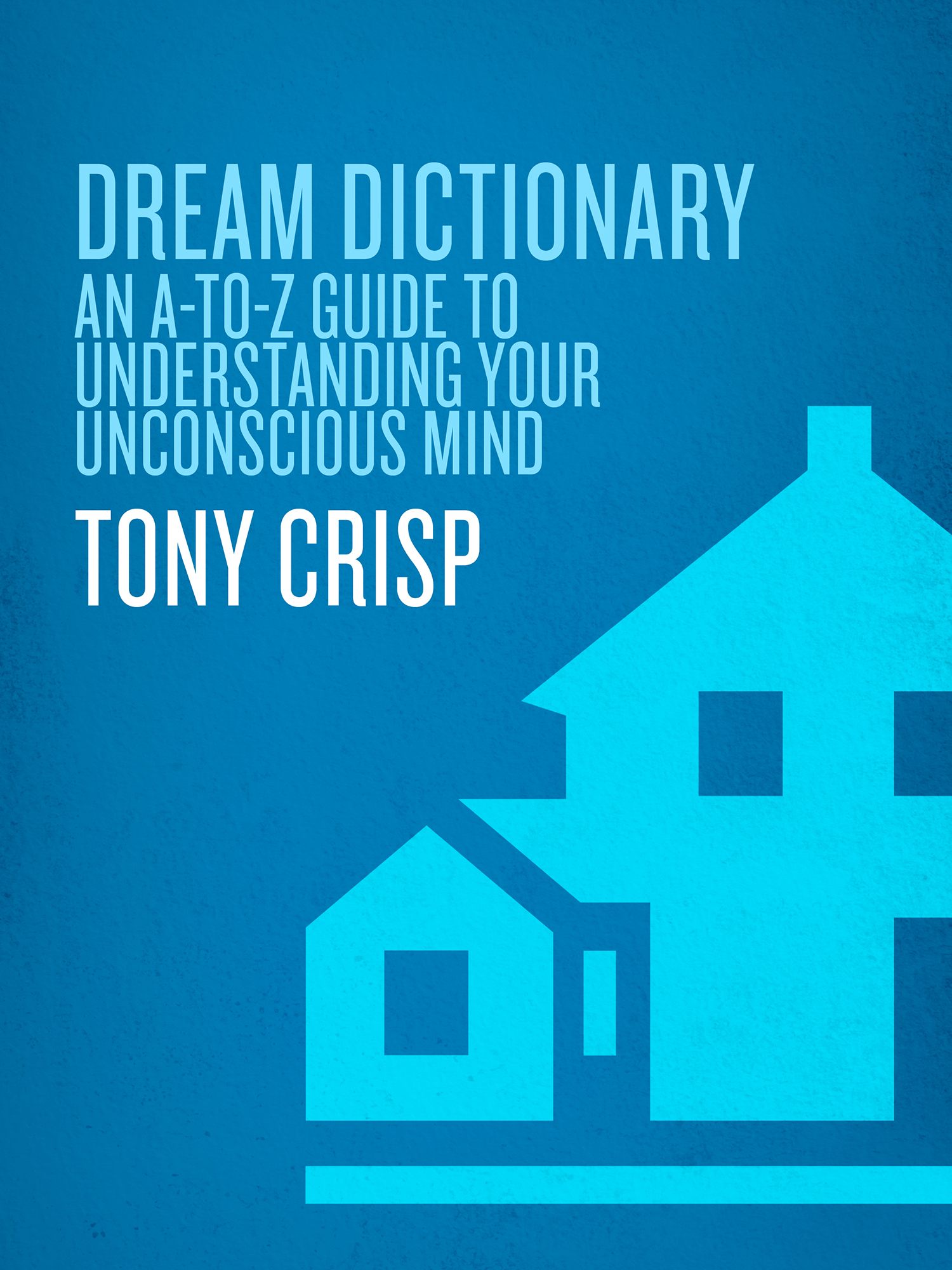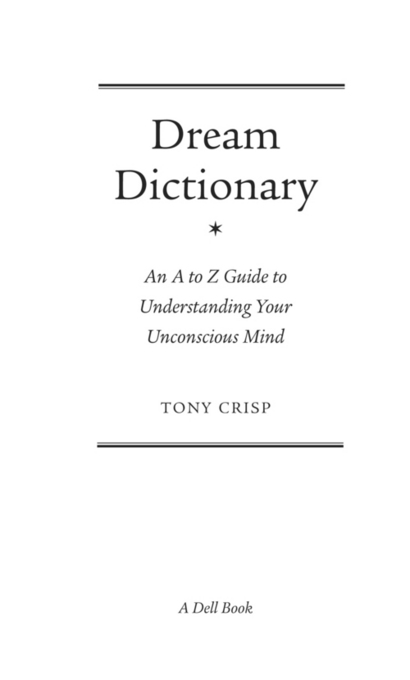Four Easy Steps to
Understanding Your Dreams
*
1. Write down your dream
2. Look up the entry that best describes the opening scene
3. Look up the symbols and the situations that occurred in your dream
4. Discover what your dream actually means
Did You Know
*
A dream can be a forewarning of things to come?
Dreams can help you solve problems in your everyday life?
Women dream more during PMS?
Revelatory dreams are more common in men?
Sleepwalking occurs most frequently in adolescence?
You can control your dreams?
You can find the key to your inner life in the
Dream Dictionary
A Dell Book
Published by
Dell Publishing
Random House, Inc.
Copyright 2002 by Tony Crisp
All rights reserved. No part of this book may be reproduced or transmitted in any form or by any means, electronic or mechanical, including photocopying, recording, or by any information storage and retrieval system, without the written permission of the Publisher, except where permitted by law.
For information address Dell Publishing, New York, New York.
Dell is a registered trademark of Random House, Inc.,
and the colophon is a trademark of Random House, Inc.
eISBN: 978-0-307-42289-7
v3.1_r1
To my children
Mark, Helen, Neal, Leon, Quentin.
This is a fruit of my life.
It has grown out of the wonder and the pain,
the struggle, the goodness, and the vision,
that are the riches in my life.
Contents
*
Introduction
*
A Dream is a mirror revealing your deepest self.
Most of us now have experience, directly or through films, of the monitors that sit next to a sick person in a hospital. We know that on the screen of the monitor a visible image can be displayed of the patients heartbeat, their blood pressure, even their brain activity. Through ultrasound one can even see the body and movements of a baby within the mothers womb.
Your dreams are like those monitors. In the mirror of your dreams you can witness what is happening in your body, in your mind, and in your most guarded self and intuitions. The hospital monitor may show things happening in your body that you are usually unconscious of. Like the monitor, dreams show things that are deeply unconscious. In this way your dreams take you into the profoundly unknown of your personality and your felt but often unconscious links with the people and world around you. In the mirror of your dreams these things appear as external people and places depicting the subtle and otherwise unknown processes of your body, your mind, and your connection with others.
At first it may be difficult to believe or grasp that the persons or objects in your dreams, like the things seen on the hospital monitor, are depicting your internal feelings and mental structure. But the experience of thousands who have explored their dreams in depth point to this possibility. And it is around this approach that Dream Dictionary is written.
Dreams cannot be defined under any one heading. Like human beings, they are enormously varied in what they express. Just as you cannot say the human mind is simply a system of memory, you cannot say dreams are just the reflection of experienced events. Your mind can also solve problems, predict the outcome of what you do, play with possibilities through imagination. You can create new ideas out of old memories, or replay disturbing events in order to find ways of meeting them constructively. Being the mental phenomena they are, dreams deal with all of these issues and more.
How Do We Know Dreams Do All These Things?
Two of the major ways we know things in todays world are through validated scientific research, and through personal experience.
Through the scientific approach we know that each of us dream about five times every night, and while we dream our eyes move, following the action in the dream (Aserinsky and Kleitman, 1952; The Dreaming Brain, J. Allan Hobson,). This is known as rapid-eye-movements or REM sleep. It was later discovered that while dreaming, your voluntary muscles are paralyzed, making it impossible or difficult to move, thus sometimes giving rise to a feeling of being possessed by a force or power outside of your will.
Professor Jerome Siegel of the UCLA School of Medicine found that duck-billed platypuses have REM sleep, suggesting that this form of sleep and the process underlying dreaming developed in early mammals 250 million years ago.
More recently, studies of brain scans while subjects were dreaming have revealed that dreams are formed by drawing on a well of emotional memories. (Dr. Chiara Portas of the Wellcome Department of Cognitive Neurology, Institute of Neurology, London.)
Because a dreaming person exhibits REM, researchers in sleep laboratories can wake people to discover what they are dreaming. According to sleep researcher Peretz Lavie, lawyers dream about courtrooms, doctors dream about operating rooms, students dream about classrooms. Dreams early in the night tend to deal with present situations, whereas dreams in the morning are more likely to go back to the dreamers early childhood.
Several researchers have found evidence that a process of learning takes place during dreaming. Because of this, the theory that dreams are nothing more than a means of dumping mental garbage from memory has not been validated. Jerold M. Lowenstein, professor of medicine at the University of California at San Francisco, says, Most researchers who study dreams reject the idea of dreams as means of garbage dumping, because dreams seem to have a narrative coherence and logic that goes beyond being just a random collection of impressions. They are convinced that REM sleep and dreams constitute a separate reality that plays a vital part in our lives and health, though the nature of that reality is not yet understood. (Quoted from the Electronic Telegraph, issue 952)
So why we need to sleep, or why we dream, still holds mysteries for the scientific community. This is because our brain and personality are such extraordinary and complex systems.
Human experience leaps beyond the laboratory. When we put together the massive information gathered from peoples experience of dreaming over the centuries, the mystery of sleep and dreams speaks to us of many possibilities. Tens of thousands of hours have been spent by individuals exploring their dreams in therapeutic settings. From their experience we can see that dreams link with an internal process that attempts to move toward the healing of internal trauma and tension. For many people such work has been life transforming. From it they have learned that the dream process continually attempts personal growth.
There are numerous instances of highly creative dreams. From such widely diverse sources as Einstein and Robert Louis Stevenson, we can gather examples of dreams that have led to breakthroughs in science, in literature, in industry, and in medicine.
Doctors such as Bernard S. Seigal, clinical professor of surgery at Yale University School of Medicine, have promoted the use of dreams in the early diagnosis of illness. (A Surgeons Experience With Dreams, by Bernard Seigal, in The Dream Network Bulletin


